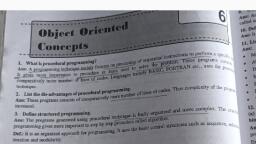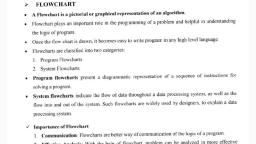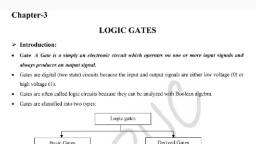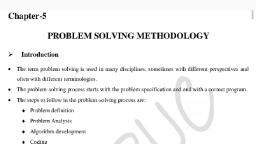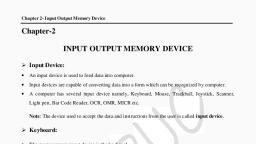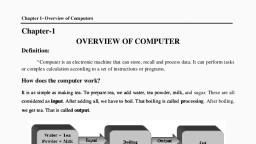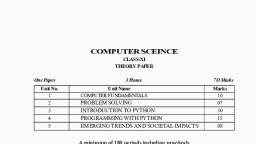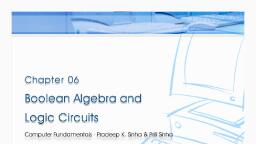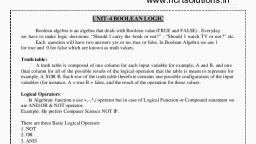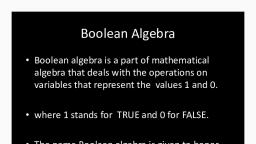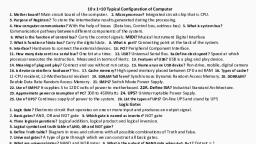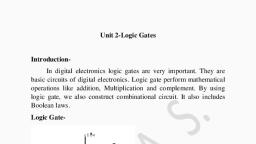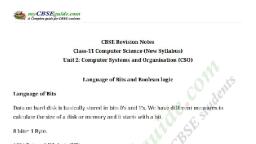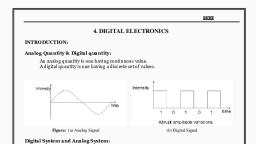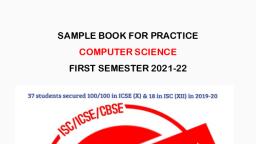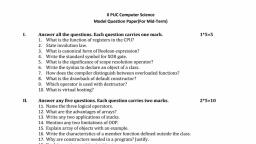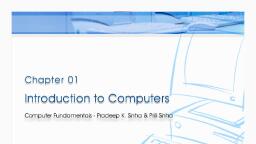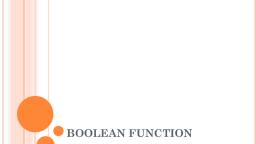Page 1 :
Chapter-2, , BOOLEAN ALGEBRA, , > Introduction:, , An algebra that deals with binary number system is called “Boolean Algebra”., , It is very power in designing logic circuits used by the processor of computer system., , The logic gates are the building blocks of all the circuit in a computer., , Boolean algebra derives its name from the mathematician George Boole (1815-1864) who is, considered the “Father of symbolic logic”., , Boolean algebra deals with truth table TRUE and FALSE., , It is also called as “Switching Algebra”., , > Binary Valued Quantities — Variable and Constants:, , A variable used in Boolean algebra or Boolean equation can have only one of two variables., The two values are FALSE (0) and TRUE (1), , A Sentence which can be determined to be TRUE or FALSE are called logical statements or, truth functions and the results TRUE or FALSE is called Truth values., , The variables which can store the truth values are called logical variables or binary valued, variables. These can store one of the two values 1 or 0., , The decision which results into either YES (TRUE or 1) or NO (FALSE or 0) is called Binary, decision., , > Truth Table:, , A truth table is a mathematical table used in logic to computer functional values of logical, expressions., A truth table is a table whose columns are statements and whose rows are possible scenarios., Example: Consider the logical expression, Logical Statement: _ Meals = “Ram prefer rice and roti for the meal”, , Y=AANDB (Logical Variables: Y, A, B, Logical Operator AND), , , , , , , , , , , , , , , , , , , , , , Ram Prefer Rice | Ram Prefer Roti Meals A B ¥, FALSE FALSE FALSE 0 0 0, FALSE TRUE FALSE 0 1 0, TRUE FALSE FALSE I 0. 10, TRUE TRUE TRUE rT a 0, , , , , , , , , , , , , , , , , , , , 1|Page Keerthi Kumar H.M
Page 2 :
If result of any logical statement or expression is always TRUE or 1, it is called Tautology and, if the result is always FALSE or 0, it is called Fallacy., , » Logical Operators:, , There are three logical operator, NOT, OR and AND., , These operators are now used in computer construction known as switching circuits., , > NOT Operator:, , The Not operator is a unary operator. This operator operates on single variable., The operation performed by Not operator is called complementation,, The symbol we use for it is bar., , X means complementation of X, , , , , , If X=1, X=0 If X=0, X=1, , The Truth table and the Venn diagram for the NOT operator is:, x |X, 1 0, , , , tr} -|@, , , , , , , , , , , , » OR Operator:, , The OR operator is a binary operator, This operator operates on two variables., The operation performed by OR operator is called logical addition., , The symbol we use for it is ‘+’., , Example; X + Y can be read as X OR Y, , The Truth table and the Venn diagram for the NOT operator is:, , Xx Y |X+¥Y, 0 0 0, , 0 1 1 Oi, 1 0 1, 1 1 1, , , , , , , , , , , , , , , , , , , , , , , , , , , , , , » AND Operator:, , The AND operator is a binary operator. This operator operates on two variables., , The operation performed by AND operator is called logical multiplication., The symbol we use for it is *.’., , Example: X . Y can be read as X AND Y, , 2|Page Keerthi Kumar H.M
Page 3 :
¢ The Truth table and the Venn diagram for the NOT operator is:, x ¥Y | SY, 0 0 0, 0 1 0, 1 0 0, 1 1 1, , , , , , , , , , , , , , , , , , , , , , , , , , , , , , » Evaluation of Boolean Expression using Truth Table:, © To create a truth table, follow the steps given below., ¢ Step 1: Determine the number of variables, for n variables create a table with 2" rows., © For two variables i.e. X, Y then truth table will need 2? or 4 rows., ©. For three variables i.e. X, Y, Z, then truth table will need 2° or 8 rows., ¢ Step 2: List the variables and every combination of 1 (TRUE) and 0 (FALSE) for the given, variables, ¢ Step 3: Create a new column for each term of the statement or argument,, , ¢ Step 4: If two statements have the same truth values, then they are equivalent., , 5, , » Example: Consider the following Boolean Expression F=X+ Y, © Step 1: This expression as two variables X and Y, then 2” or 4 rows., © Step 2: List the variables and every combination of X and Y., ¢ Step 3: Create a new column Y of the statement, and then fill the truth values of Y in that, column., ¢ Step 4: The final column contain the values of X+ Y., xX Y y X+Y, , , , , , , , , , 0 0 1 1, 0 1 0 0, 1 0 1 1, , , , 1 1 0 1, , , , , , , , , , , , , , » Exercise Problems:, 1. Prepare a table of combination for the following Boolean algebra expressions., a) XY+XyY b) XYZ +XYZ, 2. Verify using truth table for the following Boolean algebra., a) X+XY=X b) X¥Y=X.Y, , 31Page Woaarthi Wamune af as
Page 4 :
» Boolean Postulates:, , The fundamental laws of Boolean algebra are called as the postulates of Boolean algebra., These postulates for Boolean algebra originate from the three basic logic functions AND, OR, and NOT., Properties of 0 and 1:, I. IfX £0 then X = 1, and If X #1 then X =0, II. — OR relation ( Logical Addition), , a. 0+0=0 ce. 1+05u, , b. O+1=1 d. 1+2=!1, Ill. AND relation ( Logical Multiplication), , a. 0.0=0 cl .050, , b. 0.1=0 d. MQl=1, IV. Complement Rules, , a. O=1 b. 1=0, , » Principle of Duality Theorem:, , This is very important principle used in Boolean algebra., Principle of Duality states that;, o Changing each OR sign (+) to an AND sign (.), o Changing each AND sign (.) to an OR sign (+), © Replacing each 0 by | and each | by 0., The derived relation using duality principle is called dual of original expression., Example: Take postulate II, related to logical addition:, 1) 0+0=0 20+1=1 3)14+0=1 4)1+1=1, Now working according to above relations, + is changed to . and 0’s replaced by 1’s, a) T¥=1 b)1.0=0 ¢)0.1=0 d0.0=0, which are nothing but same as that of postulate III related to logical multiplication., So 1, 2, 3, 4, are the duals of a, b, c, d., , Example: Find the duals for the following Boolean Expression, , , , , , , , , , , , , , SINo Boolean Expression Duals, 1 X+0=X X.1=X, 2 X+1=1 X.0=0, 3 X.X=0 X+X=1, 4 X.(Y+Z) X+(Y.Z), 5 X+X.Y=X+Y X(X+Y)=X.Y, , , , , , , , , , , , 4|Page Keerthi Kumar H.M
Page 5 :
» Boolean Theorems:, ¢ Boolean Theorem can be proved by substituting all possible values of the variable that are 0, , and 1., , ¢ This technique of proving theorem is called Proof by perfect induction., , , , , , , , , , , , , , , , , , , , , , , , , , , , , , , , , , , , , , , , , , , , , , , , , , , , , , , , , , , , , , , , , , , , , , , , , , , , , , , , , , , , , , , , , , , , , , SINo Theorem SINo Theorem, Properties of 0 and 1 Associative Law, 1 0+X=X 12 X .Y.Z) = (X.Y).Z, 2 1+X=1 13 (X+Y).Z= X+(Y.Z), a 0.X=0 Distributive Law, 4 1.x= x 14 X.(Y+Z) = X.Y + XZ, Indempotence Law 15 X+Y.Z = (X+Y).(X+Z), 5 X+X=X Absorption Law, 6 X.X=X 16 X+XY=X, Complementary Law 17 X(X+Y) =X, 7 X+X=1 18 XY +XY=X, 8 X.X=0 19 (X+Y)(X+¥)= X, Involution Law 20 X+XY = X+Y, 9 XOX 21 X(K+Y) = XY, Commutative Law, 10 X+Y=Y+X, 1 XW=Y.X, > Theorem 1: 0+X=X, Proof: If X=0 Proof: If X=1 Using Truth Table, then LHS =0+X then LHS =0+X 0 X Ox, =0+0 =0+1 0 0 0, =a Pa 0 1 1, = RHS = RHS, > Theorem 2: 1+X=1, Proof: If X=0 Proof: If X= 1 Using Truth Table, then LHS =1+X then LHS =1+X i X x, =1+0 =i+t i 0 i, = = 1 1 I, = RHS =RHS, 5|Page Keerthi Kumar H.M
